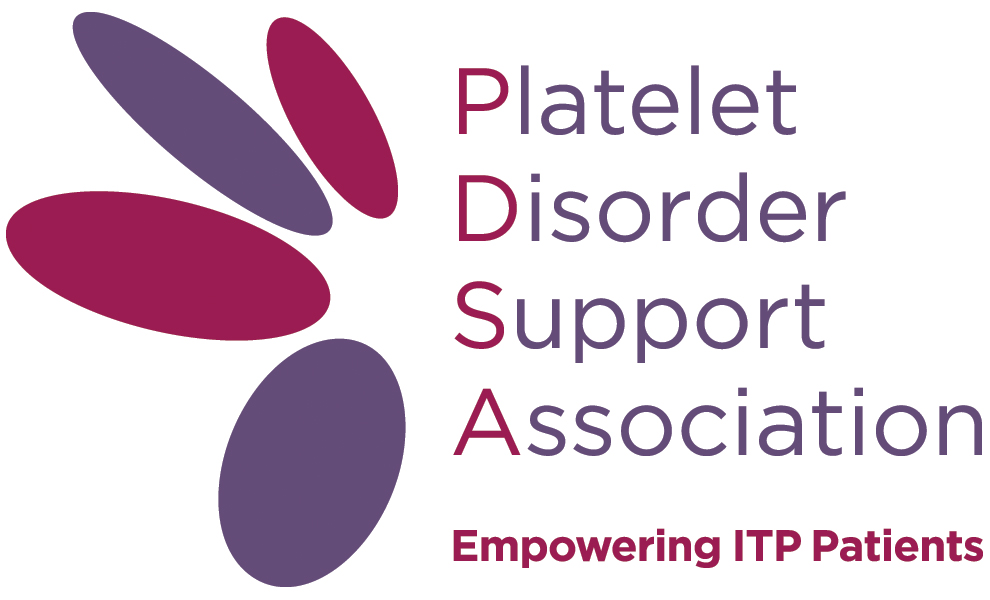THE MOST COMMON AUTOIMMUNE BLEEDING DISORDER UNKNOWN TO MOST - ITP AFFECTS 10 TIMES AS MANY PEOPLE AS HEMOPHILIA.
PDSA is a 501 (c)3 organization. Contributions are tax deductible to the extent of the law. PDSA is eligible for corporate matching programs. PDSA receives NO federal funding.
What Is ITP?
ITP, immune (idiopathic) thrombocytopenia is an autoimmune disease. In autoimmune diseases, the body mounts an immune attack toward one or more seemingly normal organ systems. In ITP, platelets are the target. They are marked as foreign by the immune system and eliminated in the spleen and sometimes, the liver. In addition to increased platelet destruction, some people with ITP also have impaired platelet production.
Platelets are relatively small, irregularly shaped components of our blood. They are required to maintain the integrity of our blood vessel walls and for blood to clot. Without a sufficient number of platelets, a person with ITP is subject to spontaneous bleeding or bruising.
People with ITP often have bruises or small purple spots on their skin (petechiae) where their blood has escaped from their veins or capillaries. Spontaneous bleeding can also occur in the mucus membranes on the inside of the mouth or in the gastrointestinal tract. It is possible, with a decreased number of platelets, to have a spontaneous cerebral hemorrhage.
Normal platelet counts range from 150,000 to 400,000 per microliter of blood. People with platelet counts below 100,000 may have ITP. People with platelet counts under 10,000 have a severe case of ITP. A count of 30,000 is sufficient for many to prevent a catastrophic bleed. Individual reactions to low platelet counts differ. Determining a safe platelet count is a decision to be made in consultation with an experienced treating physician.
Our survey indicates that ITP occurs more frequently in women than men during childbearing years. It is usually a chronic problem. ITP in children occurs at about the same rate in boys and girls. It is frequently self-correcting but may become chronic. Adolescent ITP has more of the characteristics of adult ITP.
How Is ITP Diagnosed?
ITP is diagnosed when platelets are abnormally low and other causes of low platelets have been ruled out.
People with ITP often notice bruises on their arms or legs, petechiae, nose bleeds that are difficult to stop, or bleeding gums during normal dental care. Some present no symptoms but their low platelet count is revealed during a routine blood test.
When ITP is suspected, additional diagnostic tests could be conducted to rule out other diseases. These may include a test for lupus and a bone marrow aspiration.
How Is ITP Treated?
ITP treatment is usually coordinated by a hematologist. Treatment practices vary with the severity of ITP, age of the patient, experience of the hematologist and other factors.
Treatments include (in alphabetical order) anti-D (WinRho SDF®), azathioprine (Imuran®), corticosteroids (ex. prednisone), cyclophosphomide (Cytoxan®), cyclosporine (Sandimmune®), danazol (Danocrine®), gammoglobulin (ex. IVIg), mycophenolate mofetil (Cellcept®), platelet growth stimulators romiplostim (Nplate®) and eltrombopag (Promacta®), rituximab (Rituxan®), splenectomy, and vinca alkaloids (ex. vincristine). Additional treatments are in clinical trials.
Some patients report success with complementary therapies such as vitamins, supplements, diet changes, herbs and energy work.
What Causes ITP?
The specific cause of ITP is unknown. Some cases of ITP appear after a viral or bacterial infection, immunization, exposure to a toxin, or in association with another illness such as lupus or HIV.
Approximately 5% of all women, including those without ITP, will experience a fall in platelet count during pregnancy. Women with low platelet counts who are pregnant should seek the advice of a hematologist and obstetrician experienced in the management of this condition.
ITP is rarely a communicable or inheritable disease.
What Can I Expect?
For those with ITP, the likelihood of serious complications varies with the platelet count. Many adults with ITP lead a normal life. Some require frequent medical attention to maintain a safe count. A very small percentage do not survive. Often patients with ITP make lifestyle changes to reduce the chance of life-threatening bleeding.
Most children diagnosed with ITP recover within three months. From 10 to 20% have ITP that persists beyond six months. Treatment options for these chronic cases are the same as those for adults.
Many adults report fatigue, depression, and muscle aches in association with their ITP.
For more in-depth information visit: www.PDSA.org



